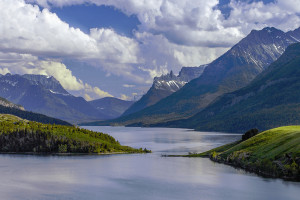- Ensure your Canadian trip is trouble-free by knowing the regulations on crossing the US/Canada border
- Crossing the border from Montana, you’ll need a current passport
- There are particular rules for crossing with children
- Document purchases made in Canada for easy crossing back to the US
With the tightening up of our border security, it’s no longer sufficient to show only a driver’s license when crossing the US/Canadian border. All travelers should be familiar with what’s required in advance to save a lot of trouble.
Where are Border Crossing Points?
When visiting Glacier National Park, you are close to many Canadian sights and towns that make great side trips. There is one border crossing into British Columbia, which is along US 93, Roosville, west of Glacier. It has 24-hour service all year round.
When going from Montana into the Province of Alberta, you can enter at the following points:
- 24-hour service
Chief Mountain on Montana Highway 17 (May to September)
Coutts on Interstate 15 - Daytime service all year (7 am to 11 pm)
Carway on US Highway 89 (closest to Glacier on the east side)
Del Bonita on Montana Highway 213
Aden on Montana Highway 409
Wild Horse on Montana Highway 232
Passport Requirements
As of June 2009, all travelers to Canada, whether by air, land or sea, need to have a passport or an equivalent travel document in order to enter the country.
Although Canadian officials don’t actually require US citizens to show a passport to enter Canada, they require all US citizens to have their passport in their possession upon entry since the person can’t re-enter the United States without one.
Passports for Children
When crossing the US/Canada border with children, there are some exceptions you should be aware of.
Research and find out what the current requirements are for children entering Canada.
Have the necessary ID ready for the customs officer. Canada Border Services suggest having an original birth or baptismal certificate or passport or an immigration document. You could also get a letter from your doctor or lawyer or the hospital where your child was born, stating you are the child’s parent or guardian.
Divorced parents should carry copies of legal custody documents. If you aren’t the parent or guardian, you would need written permission from the parents to supervise the child or children, along with the name and contact info for the parents. Parents or guardians should always travel in the same vehicle as the child when arriving at the border.
The NEXUS Card
A NEXUS card is an easy and effective way to allow travel back and forth from Canada to the United States with little delay. The prescreening permits low-risk travelers easy access through ports of entry.
NEXUS cards are only allowed at some ports of entry to Canada such as Washington State, New York and Michigan. There is no NEXUS crossing in Montana, so if coming from Glacier to British Columbia or Alberta, you will definitely need a passport to cross. You can always check with your port of entry to see if the rules have changed. It requires an interview done by both an American and a Canadian border representative.
Other Points to be Aware of
Visas
Visas are not required for US citizens if they are only planning to stay in Canada for 180 days or less. For anyone who has a criminal record, including any DWI conviction, they need to contact a Canadian Consulate or an Embassy before traveling.
Transporting Items Across the Border
US citizens must be ready to document items, purchases or gifts he or she may bring across the border in either direction.
- Entering Canada
Most items you bring with you on vacation are allowed across the border with no duty fees. Certain items may require you to post a bond to ensure they come back across the border with you on your return, but rarely tourists are required to do this. Small amounts of wine, liquor and beer are permitted. Of course, handguns are not allowed, but most hunting equipment is permitted based on the owner being 18 years of age. Bear spray is allowed across the border. - Re-entering the US
Anyone crossing the border is subject to being searched. You are entitled to a $400 exemption on personal items you are bringing back into the US after a stay of 48 hours. An exemption of $200 is allowed after a stay of less than 48 hours. Be sure to pack purchases separately and keep the receipts. Items that are forbidden by law to enter the US are prohibited, such as firearms, some fruits and vegetables and pets.






